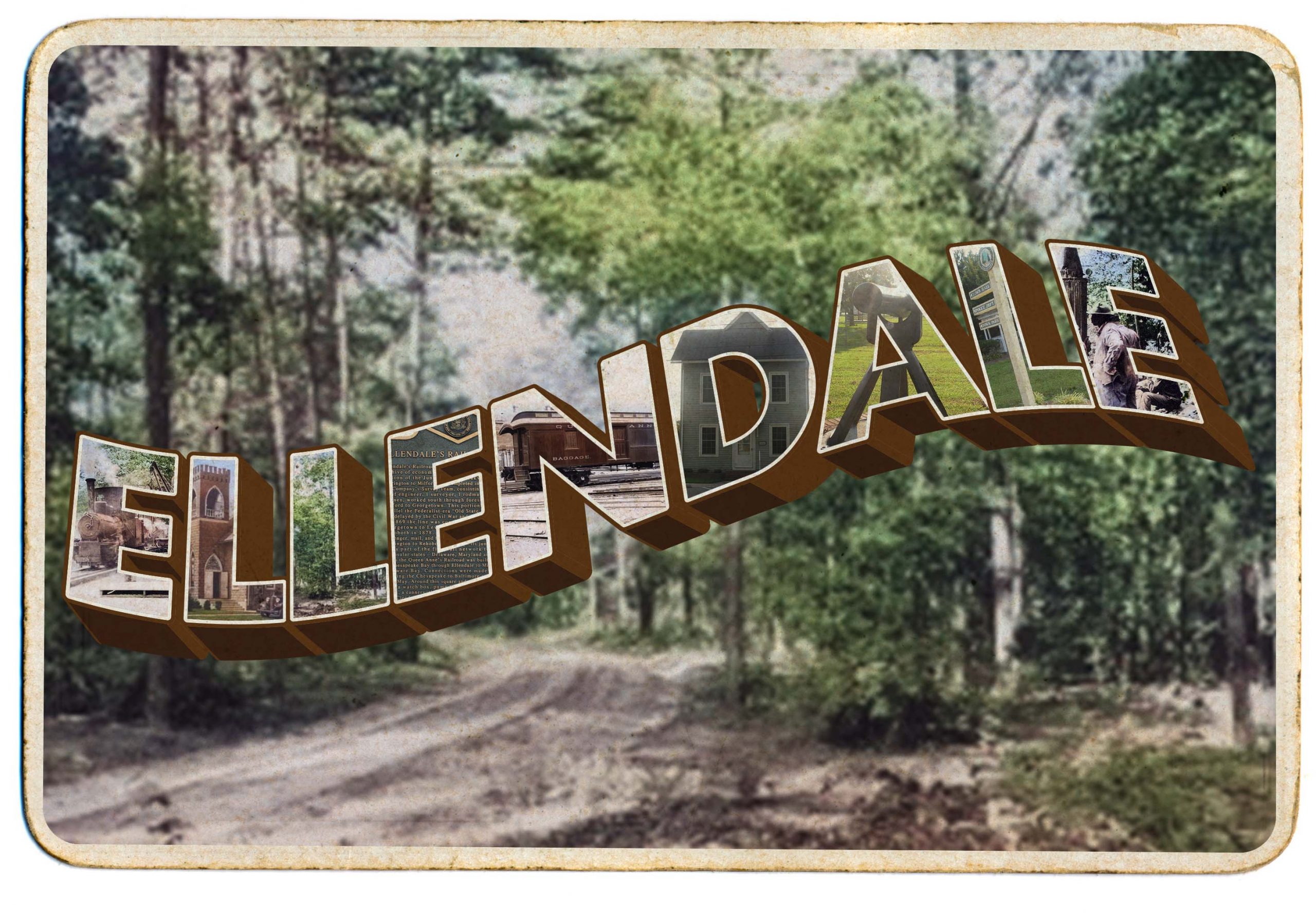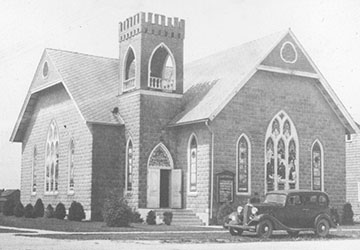


Ellendale was laid out in the latter half of the nineteenth century by Dr. John Prettyman, whose wife, according to The Origin of Certain Place Names in the United States, was the inspiration for the Town’s name.
The Town of Ellendale was first incorporated in 1905. Its town limits formed a parallelogram of 984 feet in length which was bisected in an east-west direction by the railroad. Several roads also existed in the Town and these were assigned street names and their width specifically noted in the incorporating Charter. The Town was to be governed by five Commissioners who were elected for staggered two-year terms. One of their members was to be chosen to serve as President. Other Town officials, all appointed positions, were an Alderman, a Treasurer, an Assessor, a Collector of Taxes, a Clerk, and a Constable. The Commission was to meet four times annually. The procedures for making an assessment of real estate and establishing a per capita tax were outlined. The maximum amount of taxes for the Town was $200 annually. This was to be used to maintain the roads (assisted by $200 annually from the Sussex County Levy Court) and for general improvements to the Town. New manufacturing plants were provided a ten-year exemption from being taxed. The paving of the sidewalks was the responsibility of those who owned property which fronted on it and liens could be placed on the property owner if the paving costs were not paid. The powers of the Commissioners were to regulate the streets, lanes, alleys, and sidewalks of the Town and to light them; to address nuisances and riotous acts within the Town, and to enact ordinances to preserve the health of the Town. Fines for violations were to be imposed by the Alderman assisted by the Town Constable.1
Two years after the passage of the 1905 Incorporating Act, it was amended to make minor changes in the assessment procedures.2 In 1909, it was amended again to revise the process for collecting taxes, and to outline more specifically, the duties of the Alderman.3 Ten years after the Town was incorporated, the maximum amount of annual taxation was increased from $200 to $300, and a correction was made to the Town’s metes and bounds.4 In 1917, a new section was added to the Incorporating Act which authorized the Town’s borrowing power. The Town borrowed $1,000 for the purpose of purchasing fire apparatus and for constructing a jail, by issuing municipal bonds.5 Two years later, the Town once again increased the maximum annual taxation to $500. In the same year, they increased the amount of money that could be borrowed from $1,000 to $5,000. Among the municipal projects identified for the borrowed funds were the construction of the jail and the Town’s electric light plant.6 In 1921, the Town increased the maximum amount which could be levied in taxes to $1,000,7 and in 1925, it was further increased to $1,500.8 In 1927, the amount of the Town’s borrowing power was increased again to $7,000. A provision was added that required a special tax be levied, the purpose of which was to repay the bonds at $1,000 annually. In another law that year, this amount was increased to $2,000 annually.9
No further changes were made to the 1905 Incorporating Act until 1951 at which time the Town was authorized to borrow $6,000 without a referendum or issuing bonds. These funds were for improving the streets, and a special tax was established to pay off the debt.10 The 1905 Incorporating Act was amended one last time in 1961 to address the issue of compensation for the Commissioners and certain Town officials.11
The Town was re-incorporated in 1983. As it had been over 75 years since the previous incorporation, the new Charter incorporated the amendments made since 1905 and made additional revisions. At this time, the Town consisted of a little over 160 acres, and the Charter included its metes and bounds. The Town was now to be governed by a Town Council. This Council was made up of five members who were to serve staggered two-year terms. Meetings of the Town Council are to be held monthly, and from their members, they are to elect a President and Vice-President. Other Town officials include a Secretary, a Treasurer, and a Collector of Taxes as well as a Town Solicitor, a Town Clerk and a Police Chief. The Town Council is charged with determining the amount of taxes that would be assessed annually and with collecting this. The amount of the maximum annual taxation was fixed at $1 million; however, the Town’s budget was to be based on projected expenses and the amount needed to relieve debt. In addition to real estate and/or per capita taxes, the Town can tax telephone, telegraph and electric poles. Specific remedies for non-payment of taxes are outlined. The Town Council is given the ability to exempt manufacturing plants with over six employees and those companies engaged in providing water, gas or electricity to Town residents from paying taxes. In addition to the power to assess taxes, fees, and fines, a number of additional powers are specifically listed. Along with those which had been granted in the 1905 Act, these included, but were not limited to providing an ample supply of water, providing a sewer system and/or a sewage treatment plant, providing electricity, controlling the drainage of water, providing ornamental shade trees, regulating and controlling the observance of the Sabbath, regulating the numbering of houses, instituting zoning and a building code, maintaining a jail, providing for a fire department, condemning property, establishing a pension and/or a health and welfare plan for the Town’s employees, and borrowing money, not to exceed $100,000 annually. Borrowing money generally requires a referendum and issuing of municipal bonds and the procedures for this were outlined. Other provisions of the Charter deal with streets, paving, guttering, curbing, contracts, water system, sewer system, electric power plant, drainage, the procedure for a referendum, health, fire, zoning, building inspection permits, licenses, trees, and floating debt. At the end of the Charter, the power to annex land is discussed; this action requires a referendum.12
Fifteen years after its re-incorporation, the Town of Ellendale made a number of amendments to its Charter. Among the changes made at this time were: prohibiting Council members who had a pecuniary interest in a project from participating in a vote on it; clarifying the qualifications of the Town Solicitor; clarifying that the Town could collect for attorney’s fees; increasing to $5,000 the amount of the contract which would not require a competitive bidding process; decreasing the maximum amount of funds that could be raised through the annual assessment from $1 million to $50,000; and allowing the Town to borrow up to $30,000 on a short-term basis without referendum.13
In 2006, a new power to impose an impact fee on costs associated with municipal was granted in those areas where annexation was being proposed or in cases of new development within the Town.14 In the following year, the section of the Charter related to annexation was significantly revised.15 In 2010, there were again a number of amendments to the Charter among which were several changes to the procedures for elections; changing the rate of tax on real estate from $100 to $50 per assessed value; limiting borrowing to 25% of the assessed value of the real estate in the Town and providing that a special tax be levied to repay both the principal and interest on the loan; decreasing the amount which the Town could borrow if bonds were issued form $100,000 to $60,000; and making minor changes in the annexation procedures.16
For the fully amended text of the current Charter, see http://www.Charters.delaware.gov/ellendale.shtml
CITATIONS in Del. Laws
1 23 Del. Laws, c. 186 (1905) [pp.353-65]
2 24 Del. Laws, c. 23 (1907) [p. 531]
3 25 Del. Laws, c. 199 and c. 200 (1909) [p. 397 and p. 398]
4 28 Del. Laws, c. 146 (1915) [p. 448]
5 29 Del. Laws, c. 158 (1917) [pp. 537-38]
6 30 Del. Laws, c. 145 and c. 146 (1919) [p. 330 and p. 331]
7 32 Del. Laws, c. 137 (1921) [p. 408]
8 34 Del. Laws, c. 140 (1925) [p. 356]
9 35 Del. Laws, c. 102 and c. 103 (1927) [pp. 316-17 and p. 318]
10 48 Del. Laws, c. 60 (1951) [pp. 125-26]
11 53 Del Laws, c. 223 (1961) [p. 622]
12 64 Del. Laws, c. 197 (1983) [pp. 471-93]
13 71 Del. Laws, c. 388 (1998) [pp. 1131-32]
14 75 Del. Laws, c. 259 (2006) [pp. 341-42]
15 76 Del. Laws, c. 120 (2007) [vol. I, pp. 131-35]
16 77 Del. Laws, c. 377 (2010) [vol. II, p. 345]
Delaware Laws from 1935 to present can be found online at http://delcode.delaware.gov/sessionlaws/
Town of Ellendale records at the Delaware Public Archives include:
jnl / May 30, 2018 | April 23, 2019
Related Topics: Delaware History, Ellendale, Town and City Histories